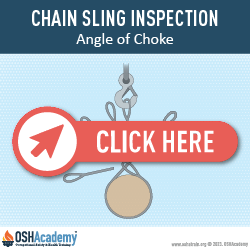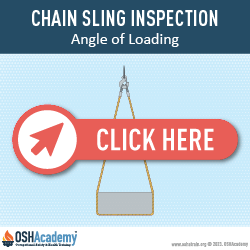Chain Slings
Inspection
Individually check each sling for the following conditions: inner link wear, bent link, stretched chain, gouges, heat damage, cuts or nicks, or damage to the end fitting. Mark any damage on the inspection form, mark the sling, and remove it from use.
Start with the end eye or fitting. Inspect the lift ring if the sling has one. Make sure that the lift eye is not distorted or pulled out of shape.
Look the eye over carefully to determine if it has been stretched or pulled over a large object. See if there is any evidence of welding or cutting of the eye.
Move to the body of the sling for signs of nicks or bent links. Examine links for evidence of over pulling. Look for melting that may have occurred around welding activities.
Chain slings that are used around welding should be protected from the heat and sparks and should never be arced or burned.
Look for wear or damage to end links used to attach the chain to the end fittings. Verify that the keeper pins are in place and that the link swivels and moves freely. Chain slings should not be welded by the link to equipment. A chain sling can be pulled tight down on a load resulting in very dangerous sling angles.
Chain slings should have no more of a sling angle than cable slings used for the same purpose.
Examine end hooks for bending and misalignment. Chain hooks should fit snugly between the links and be sized properly for the chain.
Knowledge Check Choose the best answer for the question.
7-5. When inspecting a chain sling, where should you start?
You forgot to answer the question!


